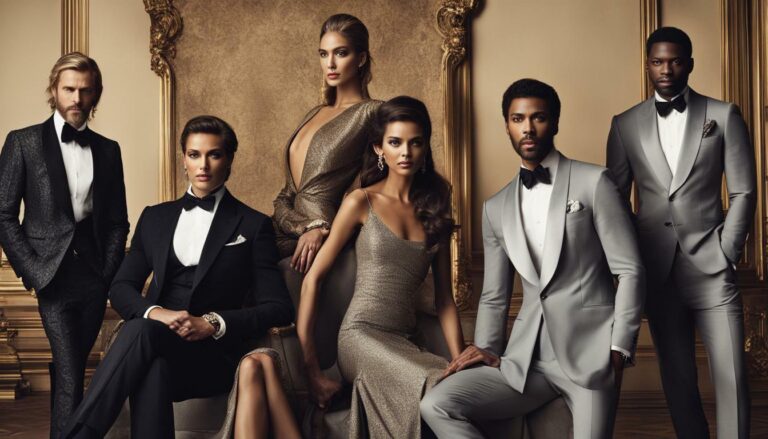When did skinny become attractive?
The concept of skinny being attractive is a relatively recent phenomenon in American culture, with a notable shift occurring in the 19th century. Before this time, Americans viewed female fatness as a sign of health and vitality. However, the industrial revolution and advancements in food science brought about changes in societal norms and beauty standards, leading to the promotion and popularization of thinness as an ideal body type.
This cultural shift in the perception of attractiveness can be attributed to various factors. Religious influences promoted abstinent diets, emphasizing self-control and discipline. The industrial revolution, with its standardized clothing sizes and increased urbanization, created a desire for a more slender body that could fit into fashionable attire.
Key Takeaways:
- The shift towards valuing thinness as an attractive trait began in the 19th century.
- Religious influences, such as abstinent diets, played a role in promoting thinness.
- The industrial revolution and advancements in food science contributed to changing beauty standards.
- The development of standardized clothing sizes and increased urbanization further reinforced the ideal of a slender body.
- Mass media and societal pressures have perpetuated the dominance of the slender body ideal.
Despite the long-standing influence of the slender body ideal, recent body positivity movements have challenged these standards and advocated for inclusivity of different body shapes. It is important to recognize that beauty ideals are subjective and can change over time, influenced by societal norms and individual preferences. Embracing diverse body shapes and sizes is essential for cultivating a healthier and more inclusive definition of attractiveness.
Shift towards valuing thinness
The shift towards valuing thinness gained momentum in the 19th century, driven by various factors that influenced societal perceptions of attractiveness. One significant influence was the rise of religious movements promoting abstinent diets. These religious groups believed that self-discipline and control over one’s physical desires were crucial for spiritual enlightenment. As a result, adherents often followed strict dietary rules that favored simple and limited food consumption, leading to weight loss and a leaner physique.
The industrial revolution also played a role in popularizing thinness as an ideal body type. With the advent of standardized clothing sizes and mass production, social pressure to conform to these sizes increased. Additionally, the accelerated urbanization brought about by industrialization led to reduced physical activity and the adoption of sedentary lifestyles, further contributing to the desire for a slimmer figure.
Advancements in food science during this period also contributed to the idealization of thinness. The development of the person scale allowed for accurate weight measurement and tracking, leading to an increased emphasis on numerical values as indicators of physical attractiveness. This focus on quantification and measurement further reinforced the notion that a thinner body was more desirable.
To illustrate the societal perception of attractiveness during this time, a quote from an 1859 publication by Reverend Sylvester Graham, an influential figure in the abstinent diet movement, states, “Bodily beauty…is in proportion to the health, strength, and purity of the body, and is as far as possible from slimness, fragility, and excessive thinness.”

| Cultural Era | Ideal Body Type |
|---|---|
| 1800s | Fuller, curvier figures |
| 1920s | Slender, boyish frames |
| Present Day | Increasing emphasis on body diversity and acceptance |
As societal norms and cultural perceptions of attractiveness continue to evolve, it is important to recognize that beauty ideals are subjective and can change over time. The emergence of body positivity movements in recent years challenges traditional standards, promoting inclusivity of different body shapes and sizes. As diverse representations gain visibility in mass media, the acceptance of varying appearances becomes more widespread, showcasing a more inclusive and accepting perspective on beauty.
The Dominance of the Slender Body Ideal
By the 1920s, dieting and calorie counting had become widely adopted practices, solidifying the ideal body as one characterized by slenderness. As societal pressures increased, individuals felt compelled to conform to this new beauty standard, driven by the belief that a thin figure equated to beauty and desirability.
The rise of mass media further perpetuated the dominance of the slender body ideal. Magazines, movies, and advertisements showcased images of thin, flawless models, setting unrealistic expectations for women and fueling the desire for weight loss. It became ingrained in popular culture that being skinny was not only attractive but also a symbol of success and self-discipline.
Societal norms played a significant role in shaping perceptions of attractiveness. The glorification of thinness was reinforced by social interactions and the constant comparison of one’s body to others. Women faced immense pressure to conform, with societal standards dictating that a slender physique was essential for acceptance and social status.

Despite the persistent influence of the slender body ideal, body positivity movements have emerged in recent years, challenging traditional beauty standards. These movements advocate for inclusivity, celebrating diverse body shapes and sizes. They aim to shift the cultural perception of attractiveness towards a more accepting and inclusive mindset, emphasizing that beauty comes in various forms and cannot be confined to a single narrow standard.
Beauty ideals are subjective and can change over time. Society’s perception of attractiveness is influenced by a complex interplay of cultural, historical, and individual factors. As we continue to question and challenge societal norms, it is crucial to promote body positivity and embrace the diversity of human bodies.
| Dieting and Calorie Counting | Societal Pressures | Mass Media | Cultural Perception of Attractiveness |
|---|---|---|---|
| – Became widely adopted practices | – Compelled individuals to conform | – Reinforced the slender body ideal | – Shaped by societal norms |
| – Solidified the ideal as slenderness | – Increased pressure to be thin | – Showcased thin, flawless models | – Glorified thinness as success |
| – Symbolized beauty and desirability | – Established unrealistic expectations | – Set unrealistic standards | – Reinforced through social interactions |
Shifting Beauty Standards and Body Positivity
Recent years have witnessed a rise in body positivity movements that challenge the narrow beauty standards and emphasize the importance of inclusivity. These movements aim to shift societal norms of beauty that have long favored a slender body ideal. By promoting acceptance and celebration of different body shapes, body positivity advocates seek to create a more inclusive and diverse perception of attractiveness.
One of the key messages of the body positivity movement is that beauty ideals are subjective and can change over time. This challenges the notion that there is one “ideal” body type and encourages individuals to embrace their own unique features. It highlights the harmful effects of comparing oneself to unrealistic standards perpetuated by mass media and societal pressures.
The body positivity movement also acknowledges the impact of societal norms on body image. It recognizes that beauty standards are not fixed, but influenced by cultural factors, historical trends, and individual preferences. This perspective encourages a more compassionate and understanding approach towards different body shapes and sizes.
The Importance of Inclusivity
Central to the body positivity movement is the idea of inclusivity. It seeks to challenge the marginalization and exclusion of individuals who do not fit traditional beauty standards. By promoting acceptance and representation of diverse body shapes, skin colors, and abilities, body positivity advocates aim to create a more inclusive society where everyone feels valued and respected.
The impact of body positivity goes beyond individual empowerment. It has the potential to reshape industries and institutions that perpetuate narrow beauty ideals. Many brands and media outlets are recognizing the importance of inclusivity and the need to represent a wider range of body types. By embracing diversity, they can connect with a broader audience and contribute to a more inclusive culture.
In conclusion, the rise of body positivity movements reflects a growing recognition of the damaging effects of narrow beauty standards and the importance of inclusivity. Through challenging societal norms and promoting acceptance of different body shapes, these movements seek to create a more diverse and compassionate perception of beauty. By embracing the notion that beauty ideals can change over time and are subjective, individuals can foster a healthier relationship with their bodies and contribute to a more inclusive society.
Conclusion
In conclusion, the concept of skinny being attractive in American culture has seen a significant shift over time, influenced by various socio-cultural factors. Before the 1800s, Americans actually viewed female fatness as a sign of health and vitality, with curvier figures being the ideal. However, in the 19th century, there was a gradual change in beauty standards, driven by factors such as religious influences promoting abstinent diets, the industrial revolution leading to standardized clothing sizes and increased urbanization, advancements in food science, and the development of the person scale.
By the 1920s, dieting and calorie counting became commonplace, marking a clear shift towards valuing thinness. This ideal body type has remained dominant in American society, perpetuated by mass media and societal pressures. However, in recent years, body positivity movements have emerged, challenging these beauty standards and promoting inclusivity of different body shapes. This movement recognizes that beauty ideals are subjective and can change over time, influenced by societal norms and individual preferences.
It is important to understand that beauty comes in all shapes and sizes, and no one body type should be considered the ultimate standard of attractiveness. Embracing diversity and promoting body positivity allows individuals to celebrate their uniqueness and feel confident in their own skin, regardless of societal expectations. As we continue to evolve as a society, it is crucial to foster a culture that values self-acceptance, inclusivity, and a healthy body image for everyone.
FAQ
When did skinny become attractive?
The concept of skinny being attractive is a relatively recent phenomenon in American culture. The shift towards valuing thinness began in the 19th century.
What factors led to valuing thinness?
The shift towards valuing thinness was driven by factors such as religious influences promoting abstinent diets, the industrial revolution leading to standardized clothing sizes and increased urbanization, advances in food science, and the development of the person scale.
How did the slender body ideal become dominant?
By the 1920s, dieting and calorie counting became commonplace, further reinforcing the slender body ideal. Mass media and societal pressures played a significant role in perpetuating this beauty standard.
Are there challenges to traditional beauty standards?
Yes, there are body positivity movements challenging traditional beauty standards and promoting inclusivity of different body shapes. These movements emphasize that beauty ideals are subjective and can change over time, influenced by societal norms and individual preferences.
Do beauty ideals change over time?
Yes, beauty ideals are fluid and subject to change. They are influenced by societal shifts, cultural influences, and changing beauty standards. Embracing diverse body shapes and sizes is encouraged.
Source Links
- https://theconversation.com/womens-idealised-bodies-have-changed-dramatically-over-time-but-are-standards-becoming-more-unattainable-64936
- https://www.livescience.com/18131-women-thin-dieting-history.html
- https://www.salon.com/2022/12/27/thin-bodies-werent-always-attractive-a-brief-history-of-culturally-relative-beauty-standards/






